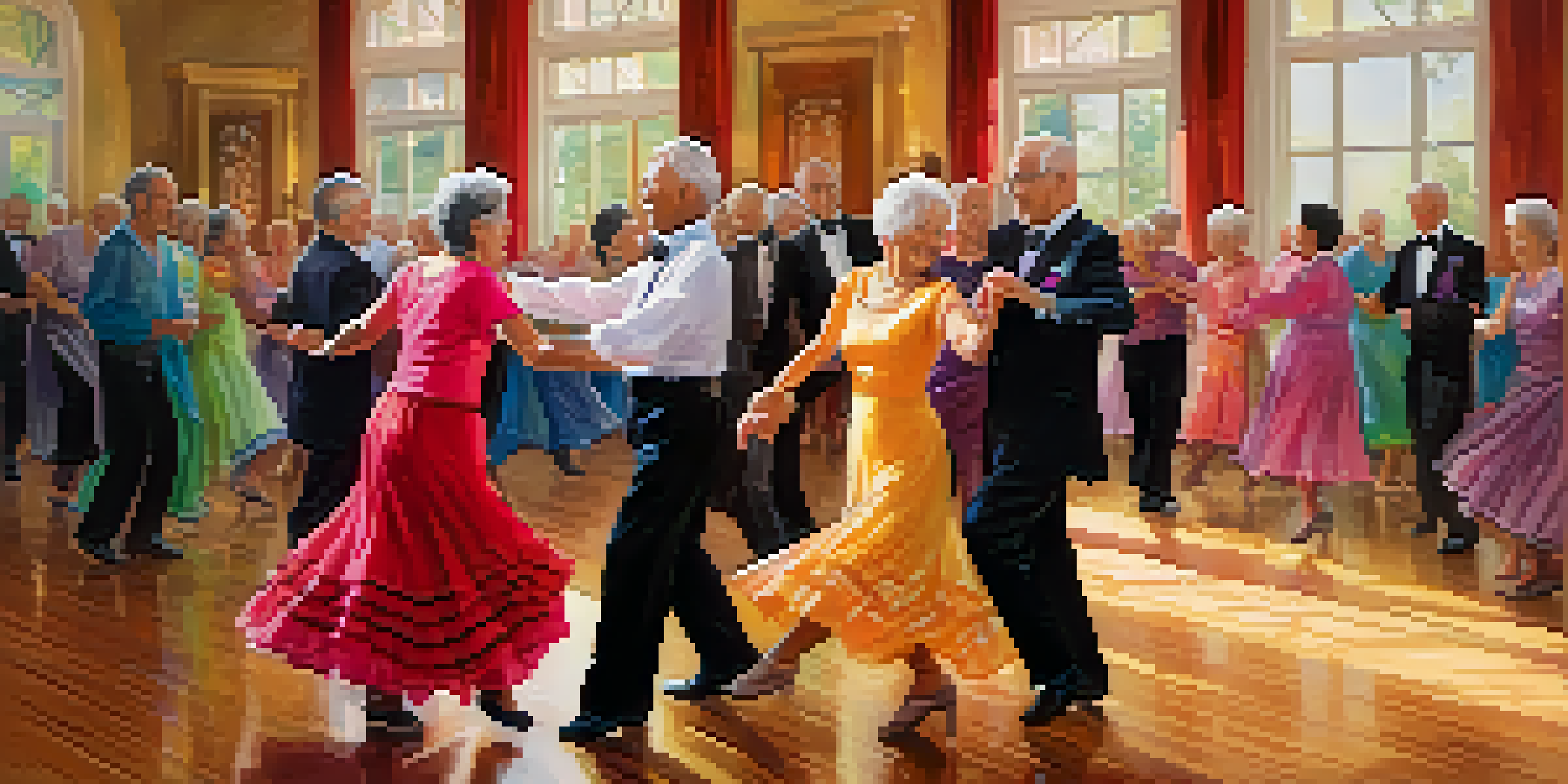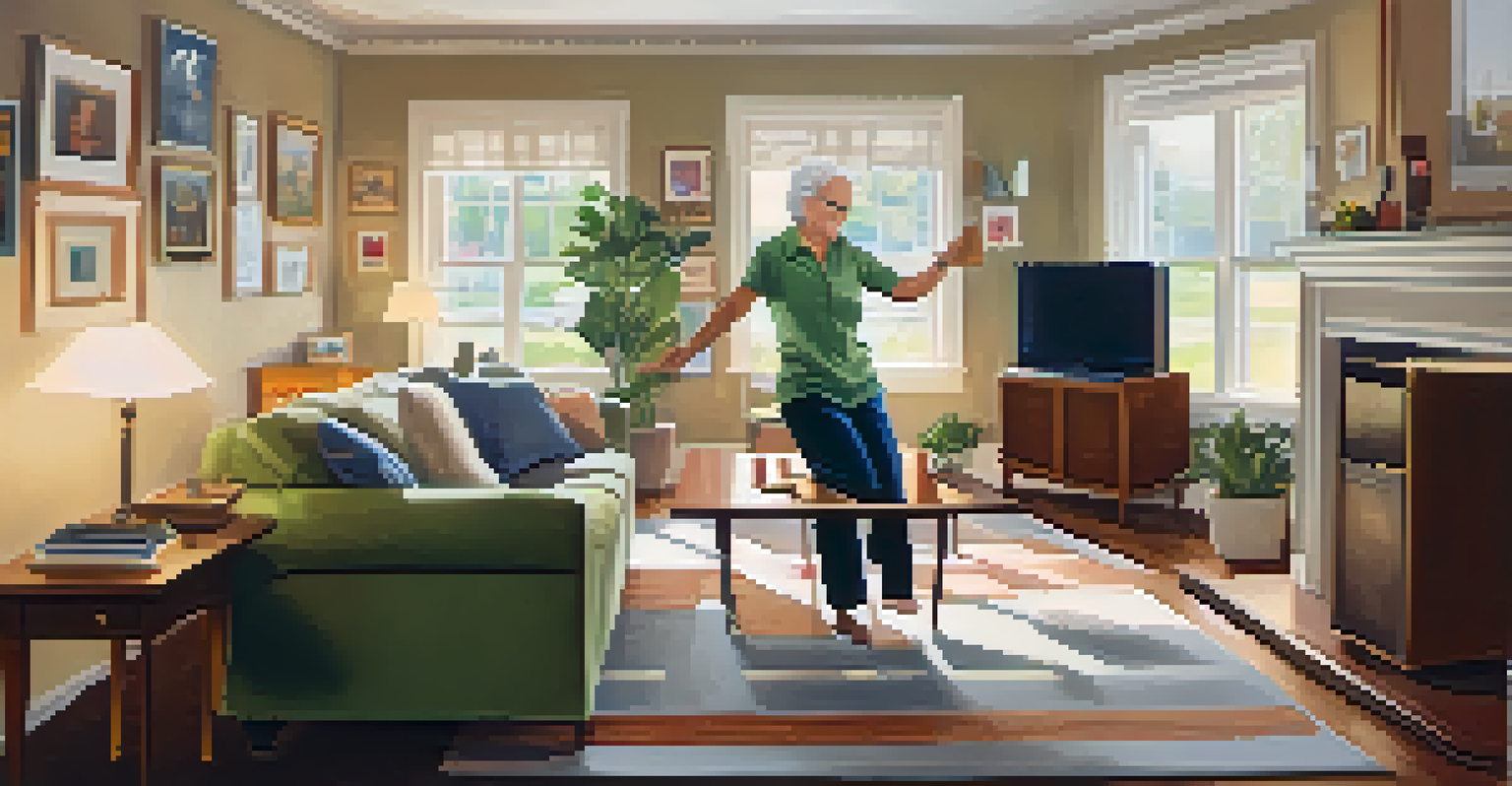Social Connections Through Dance: A Key for Aging Well

The Importance of Social Connections in Aging
As we age, maintaining social connections becomes increasingly vital. Research shows that strong social ties can lead to better health outcomes, including lower rates of depression and cognitive decline. In essence, these relationships are not just a source of joy; they play a crucial role in our overall well-being as we grow older.
The greatest gift of life is friendship, and I have received it.
Social interactions help keep our minds sharp and our spirits high. Engaging with others can provide a sense of purpose and belonging, which is especially important during retirement or after significant life changes. As we nurture these connections, we also nurture our emotional health, making it easier to navigate the challenges of aging.
One of the most delightful ways to forge and strengthen these connections is through dance. Participating in dance classes or social dance events creates a natural environment for meeting new people and fostering friendships. This vibrant activity not only brings joy but also encourages social engagement, making it a wonderful tool for aging well.
Dance as a Community Builder
When people come together to dance, they create a unique sense of community that transcends age barriers. Whether it's a ballroom class or a local salsa night, dance events often attract diverse groups, fostering intergenerational connections. This inclusivity helps everyone feel welcome and valued, enhancing social bonds.

Moreover, dancing in a group setting encourages teamwork and cooperation. As participants learn new steps or routines, they rely on each other for support and encouragement. These collaborative experiences not only build camaraderie but also develop a sense of accountability, which can be motivating and uplifting.
Social Connections Boost Well-Being
Maintaining strong social ties is crucial for health, reducing risks of depression and cognitive decline as we age.
The joy of dance is contagious, and this shared experience can lead to lasting friendships. Many dancers find themselves returning to the same events, creating a reliable network of companions. This continuity provides emotional support, making the challenges of aging feel a little lighter.
Physical Benefits of Dance for Seniors
Dance isn’t just a social activity; it also offers numerous physical health benefits. Engaging in dance can improve balance, flexibility, and cardiovascular health, which are crucial as we age. These physical advantages help reduce the risk of falls and other injuries, promoting a more active lifestyle.
Dance is the hidden language of the soul.
Additionally, dance can be a fun way to incorporate exercise into daily routines. Unlike traditional workouts, dancing feels less like a chore and more like a celebration. This enjoyment can motivate seniors to stay active, which is essential for maintaining their independence and overall quality of life.
Moreover, regular physical activity through dance can contribute to better mental health. Exercise releases endorphins, the body's natural mood lifters, which can combat feelings of loneliness or isolation. Thus, the combination of movement and social interaction makes dance a powerful ally in promoting healthy aging.
Dance and Cognitive Function
Engaging in dance is also beneficial for cognitive function, particularly in older adults. Learning new dance routines requires focus, memory, and coordination, all of which stimulate brain activity. This cognitive engagement can help keep the mind sharp and may even reduce the risk of dementia.
Research indicates that activities involving both physical and mental challenges, like dance, are particularly effective in promoting brain health. As dancers learn new steps or adapt to different styles, they exercise their problem-solving skills and enhance cognitive flexibility. This dual engagement is essential for maintaining mental acuity over time.
Dance Enhances Physical Health
Engaging in dance improves balance, flexibility, and cardiovascular health, promoting a more active lifestyle for seniors.
Additionally, the social aspect of dance creates a stimulating environment that encourages conversation and interaction. These social exchanges further enhance cognitive function, as they require quick thinking and communication. In this way, dance becomes a delightful way to keep both the body and mind active.
Emotional Well-Being Through Dance
The emotional benefits of dance cannot be overstated, especially for seniors. Dance provides an outlet for self-expression and creativity, allowing individuals to convey their feelings in a joyful and liberating way. This form of expression can be particularly beneficial for those who may struggle to communicate their emotions verbally.
Moreover, the rhythmic movement of dance can often evoke positive memories and emotions. Many seniors find themselves reminiscing about joyful moments in their lives while dancing, which can enhance their mood and overall outlook. This emotional uplift can be essential in combating feelings of sadness or isolation that sometimes accompany aging.
In group settings, the shared laughter and enjoyment of dance create a positive atmosphere that fosters emotional connections. As participants bond over their shared experiences, they cultivate a supportive network that can help buffer against the emotional challenges of aging. This camaraderie is a vital ingredient for maintaining a sense of happiness and fulfillment.
Accessible Dance Opportunities for Seniors
Fortunately, there are many accessible dance opportunities for seniors, catering to various interests and abilities. From gentle ballroom classes to lively line dancing sessions, these activities are designed to be inclusive and enjoyable. Many community centers and local organizations offer classes specifically aimed at older adults, making it easier to get started.
Additionally, online dance classes have surged in popularity, providing an alternative for those who may prefer to dance at home. These virtual options allow seniors to explore different styles of dance at their own pace and comfort level. The flexibility of online classes ensures that anyone can participate, regardless of mobility or transportation challenges.
Dance Fosters Emotional Resilience
Through self-expression and shared experiences, dance helps seniors combat feelings of isolation and enhances emotional well-being.
Moreover, social media and local groups can connect seniors with dance partners or groups in their area. These platforms can facilitate the formation of dance clubs or meet-ups, further enhancing the social aspect of dancing. By making dance more accessible, we open the door for more seniors to experience the multitude of benefits it offers.
Creating a Personal Dance Routine
Creating a personal dance routine can be a wonderful way for seniors to engage with dance on their own terms. Whether it’s in the living room or at a community center, having a space to dance freely allows for self-expression and enjoyment. This personalized approach fosters a sense of ownership and motivation, encouraging regular practice.
Seniors can draw inspiration from their favorite music, incorporating songs that hold special memories. This connection to music can evoke feelings of happiness and nostalgia, enriching the overall dancing experience. As they move to the rhythm, they not only exercise but also revisit cherished moments from their past.

In addition to physical benefits, having a personal dance routine offers a sense of accomplishment. Setting goals, whether it’s mastering a new step or dancing for a certain amount of time, can boost self-esteem and provide a sense of purpose. This personal journey through dance can profoundly impact emotional and mental well-being, making it a fulfilling endeavor.